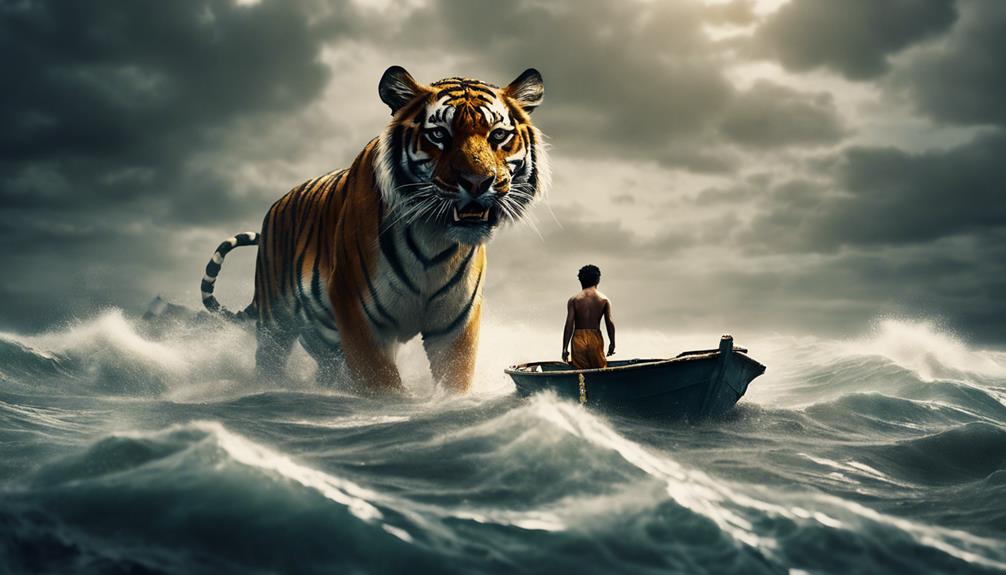Embark on an emotional journey in 'Life of Pi,' exploring a voyage of survival and resilience like no other. Experience the captivating tale of a young man's battle against nature's forces, forging an unexpected bond with the fierce Richard Parker. Explore the themes of truth, storytelling, and faith that underlie Pi's extraordinary narrative. Uncover the profound symbolism of the lifeboat as a refuge amidst isolation and salvation. Investigate the depths of human endurance and the philosophical contemplations on survival and resilience. Discover the transformative impact of 'Life of Pi,' where storytelling becomes a tool for navigating life's challenges.
The Power of Storytelling
Indubitably, the power of storytelling shines brightly in Yann Martel's 'Life of Pi'. Through the character of Pi, the novel explores the intricate relationship between storytelling, truth, and interpretation.
Pi's survival ordeal at sea with the Bengal tiger, Richard Parker, serves as a canvas for his storytelling as a coping mechanism. Martel challenges readers to navigate the blurred lines between reality and fiction, prompting them to ponder the deeper truths that stories can convey.
As you journey through 'Life of Pi', you're faced with the task of discerning the truth within Pi's narrative. The novel presents multiple versions of events, leaving the interpretation open-ended for the reader to grapple with. This ambiguity underscores the subjective nature of storytelling and the elusive nature of truth.
Themes of Truth and Meaning
Within 'Life of Pi', the exploration of truth and meaning unfolds through Pi's quest for understanding amidst the complexities of storytelling. Yann Martel weaves a narrative that blurs the lines between reality and fiction, challenging readers to discern the deeper truths hidden within Pi's story.
Pi's journey isn't just a physical one across the Pacific Ocean but a spiritual quest to uncover the essence of truth and meaning in life.
Through Pi's various storytelling techniques, Martel prompts readers to reflect on the power of stories in shaping our understanding of the world. The novel raises questions about the nature of truth and the importance of finding meaning in the face of adversity.
As readers navigate through Pi's tale of survival, they're encouraged to contemplate the role of storytelling in interpreting reality and finding deeper truths in the universe. Martel leaves the interpretation of Pi's story open-ended, inviting readers to ponder the complexities of truth and the significance of storytelling in shaping our perceptions of the world.
Pi's Journey at Sea

Pi's journey at sea unfolds as a gripping tale of survival against all odds, with a Bengal tiger as his unexpected companion. Throughout Pi's odyssey, he navigates the vast Pacific Ocean, battling not only the physical challenges of being stranded on a lifeboat but also the emotional turmoil of sharing the space with Richard Parker.
The central conflict arises from the juxtaposition of Pi's instinctual fear of the tiger with his desperate need for companionship in the face of isolation.
As the days turn into months, Pi's faith in God becomes a cornerstone of his resilience. His unwavering belief sustains him, offering solace in moments of despair and a sense of purpose in the midst of hopelessness.
Despite the harsh realities of survival at sea, Pi finds moments of peace and connection with Richard Parker, blurring the lines between predator and companion. This complex relationship between Pi and the tiger underscores the delicate balance between fear and trust in his fight for survival.
Richard Parker: Friend or Foe?
Throughout 'Life of Pi', the character of Richard Parker remains a compelling enigma, challenging readers to ponder his true nature as either friend or foe in Pi's struggle for survival.
Pi's relationship with Richard Parker is a tumultuous one, evolving from initial fear and resentment to a complex bond of mutual dependence. The tiger symbolizes Pi's inner darkness and primal survival instincts, mirroring the duality of human nature in extreme circumstances.
Richard Parker's presence serves as a metaphor for Pi's inner struggles and the thin line between friend and foe.
The development of Pi's relationship with Richard Parker highlights the complexity of human-animal connections in times of adversity.
The ambiguity surrounding Richard Parker's character prompts reflection on the role of primal instincts in shaping survival strategies and moral decisions at sea.
Survival Instincts and Strategies

Richard Parker's presence as a symbol of Pi's inner struggles sets the stage for an exploration of survival instincts and strategies amidst the harsh realities of being stranded at sea. Pi's survival instincts are ignited by the dire circumstances of a shipwreck, propelling him to plan for sustenance, hydration, and protection while adrift in the Pacific Ocean on a lifeboat with the imposing Bengal tiger, Richard Parker.
His ability to adapt, think innovatively, and forge a connection with Richard Parker proves instrumental in tackling the challenges of survival. The novel delves into the psychological and emotional dimensions of endurance in extreme conditions, highlighting Pi's resilience, determination, and resourcefulness as he confronts the unforgiving elements.
Through his unwavering spirit and strategic maneuvers, Pi exemplifies the indomitable human capacity to endure and triumph over adversity, showcasing the profound impact of survival instincts and strategies when faced with insurmountable odds.
Ambiguity in Interpretation
You can explore the rich symbolism in 'Life of Pi' and how it influences the interpretation of Pi's journey. Your perspective as a reader plays an essential role in shaping how you perceive the events in the story.
The ambiguity in Pi's narratives challenges you to question what's real and what's imagined, adding layers of complexity to the tale.
Symbolism in Storytelling
Symbolism in 'Life of Pi' infuses the narrative with layers of meaning that invite readers to explore the ambiguous depths of interpretation.
- Animals as Symbols: Throughout the story, animals like Richard Parker symbolize different aspects of Pi's psyche, with Richard Parker embodying Pi's inner darkness and hatred.
- Ambiguous Endings: The unresolved ending of the narrative allows for multiple interpretations, enriching the reader's experience and fostering contemplation on the story's themes.
- Metaphorical Landscapes: The island in the tale functions as a metaphor for Pi's boat, showcasing the intricate web of symbolism interwoven into the storytelling.
In 'Life of Pi', symbolism serves as a vehicle for conveying profound meanings beyond the literal events, challenging readers to explore the narrative's symbolic tapestry to uncover the layers of interpretation hidden within Pi's journey of survival and self-discovery.
Viewer's Perspective Influence
The interpretation of 'Life of Pi' is greatly influenced by your perspective, shaping how you perceive the depth and meaning of the story. As you engage with Pi's life, your unique viewpoint influences how you interpret the symbolic elements woven throughout the narrative.
Each viewer brings a different lens based on their own experiences and beliefs, leading to diverse interpretations of Pi's journey of survival. The ambiguity in the story allows for a range of understandings, inviting you to explore the symbolic layers and uncover the allegorical significance hidden within Pi's odyssey.
Your personal background and worldview play a pivotal role in decoding the subtle messages and nuanced themes present in the tale. Embracing the open-ended nature of 'Life of Pi' enables you to investigate the richness of its interpretation, offering a more profound connection to the narrative as you navigate the symbolic complexities with your unique perspective.
Resilience in Adversity

Amidst the turbulent waters and the looming presence of a Bengal tiger, Pi's unwavering resilience shone as a beacon of hope in 'Life of Pi'. His ability to endure unimaginable challenges and thrive in the face of adversity is a testament to the strength of the human spirit.
Here are three key aspects that highlight Pi's remarkable resilience:
- Survival Instincts: Pi's innate survival instincts kicked in as he navigated the treacherous waters, constantly adapting to his surroundings and finding ways to outsmart the dangers lurking around him.
- Mental Fortitude: Despite facing isolation, fear, and loss, Pi's mental fortitude remained unbroken. He found solace in his inner strength, enabling him to confront his fears head-on and persevere through the toughest of times.
- Personal Growth: Through his journey of survival, Pi underwent significant personal growth. The challenges he encountered pushed him to discover newfound capabilities and depths within himself, transforming him into a stronger and more resilient individual.
Symbolism of the Lifeboat
The lifeboat in 'Life of Pi' isn't just a vessel; it serves as your sanctuary, your isolation, and ultimately, your salvation.
It encapsulates the essence of your journey, mirroring the complexities of your inner struggles and external challenges.
As you navigate the vast ocean, the lifeboat becomes more than just a means of physical survival; it becomes a symbol of your resilience and faith.
Lifeboat as Sanctuary
Within the story 'Life of Pi', the lifeboat emerges as a profound symbol of sanctuary, encapsulating Pi's journey of survival and self-discovery.
The lifeboat serves as a sanctuary for Pi in the vast, unforgiving ocean, providing him with a physical space where he can seek refuge and safety amidst the chaos of his surroundings. It becomes a beacon of hope and resilience for him in the face of overwhelming adversity.
- The lifeboat symbolizes a sanctuary of survival, offering Pi a lifeline in his desperate fight against the elements and his own inner demons.
- Through the lifeboat, Pi undergoes a profound transformation, evolving from a scared and helpless boy into a determined survivor who learns to adapt and thrive in the most hostile of environments.
- Pi's journey on the lifeboat represents a quest for self-discovery, as he grapples with his identity, beliefs, and purpose in the face of extreme challenges, ultimately emerging stronger and more enlightened.
Lifeboat as Isolation
Symbolizing isolation and confinement, the lifeboat in 'Life of Pi' explores Pi's internal struggles and survival instincts as he navigates the harsh realities of solitude and the human-animal dynamic. Constrained within the limited space of the lifeboat, Pi experiences the profound sense of isolation that comes with being adrift at sea. The lifeboat becomes a physical representation of his confinement, mirroring the emotional and psychological challenges he faces while fighting for survival.
In this confined space, Pi confronts the stark truth of his solitude, highlighting the depths of his resilience and adaptability. The lifeboat not only serves as a vessel for physical survival but also as a stage for Pi's internal battles with fear, despair, and hope. As Pi grapples with the elements and his own inner demons, the lifeboat acts as a crucible where his determination and will to live are tested.
Through the symbolism of the lifeboat, 'Life of Pi' delves into the complexities of isolation, confinement, and the human spirit's unyielding drive for survival.
Lifeboat as Salvation
Sailing through the tumultuous waters of 'Life of Pi,' the lifeboat emerges as a beacon of salvation, embodying hope and resilience in the face of adversity. The lifeboat symbolizes more than just a vessel; it becomes a lifeline for Pi and Richard Parker, encapsulating their journey of survival and transformation amidst the vast expanse of the ocean.
Here's how the lifeboat in 'Life of Pi' embodies salvation:
- Symbol of Survival: The lifeboat serves as an essential element for Pi and Richard Parker's survival, providing them with a limited yet important space to navigate the challenges of the open sea.
- Microcosm of their Journey: Within the confines of the lifeboat, Pi and Richard Parker face numerous trials and tribulations, reflecting the larger journey of their survival and resilience against nature's forces.
- Sanctuary of Resilience: Despite its fragility, the lifeboat becomes a sanctuary where Pi's inner strength and transformation thrive, showcasing the human spirit's resilience in the face of overwhelming odds.
Philosophical Reflections on Survival

Prompting deep introspection, Pi's survival journey in 'Life of Pi' sparks profound philosophical reflections on faith, storytelling, and resilience. Through Pi's existential odyssey, readers are compelled to contemplate the complexities of human nature and the quest for meaning amidst adversity. Martel's narrative intertwines survival with existential themes, challenging individuals to ponder the significance of endurance in shaping identity and beliefs.
The novel serves as a platform for exploring how survival experiences can lead to profound philosophical introspection and personal growth. By intertwining Pi's resilience with existential inquiries, 'Life of Pi' explores the intricate relationship between survival, faith, and storytelling. Readers are invited to reflect on how the struggle for survival can shape one's understanding of existence and the boundaries of human capability.
Ultimately, Pi's journey encourages philosophical contemplation on the nature of faith, the power of storytelling, and the resilience of the human spirit.
Impact of 'Life of Pi
The enduring resonance of 'Life of Pi' extends beyond literature, impacting readers and sparking contemplation on themes of survival, faith, and storytelling.
Richard Parker: The enigmatic presence of Richard Parker, the Bengal tiger, symbolizes the primal instincts within us, challenging readers to confront their own inner demons and fears.
Indian State of Emergency: Through Pi's journey during the Indian state of emergency, readers are reminded of the fragility of civilization and the resilience of the human spirit in the face of adversity.
Storytelling and Faith in a Higher Power: The blending of storytelling and faith in a higher power in 'Life of Pi' prompts readers to ponder the role of belief in shaping our perceptions of reality and providing hope in dire circumstances.
The novel invites reflection on the power of narratives to sustain us through life's trials and tribulations, leaving a profound impact on those who explore its depths.
Conclusion
As you reflect on Pi's incredible journey, remember that life is like a vast ocean, full of unpredictable waves and dangerous storms.
But through resilience and storytelling, we can navigate through even the toughest challenges.
Just like Pi, we must find the strength within ourselves to overcome adversity and embrace the unknown.
So, immerse yourself in the depths of 'Life of Pi' and discover the power of survival, truth, and the human spirit.



